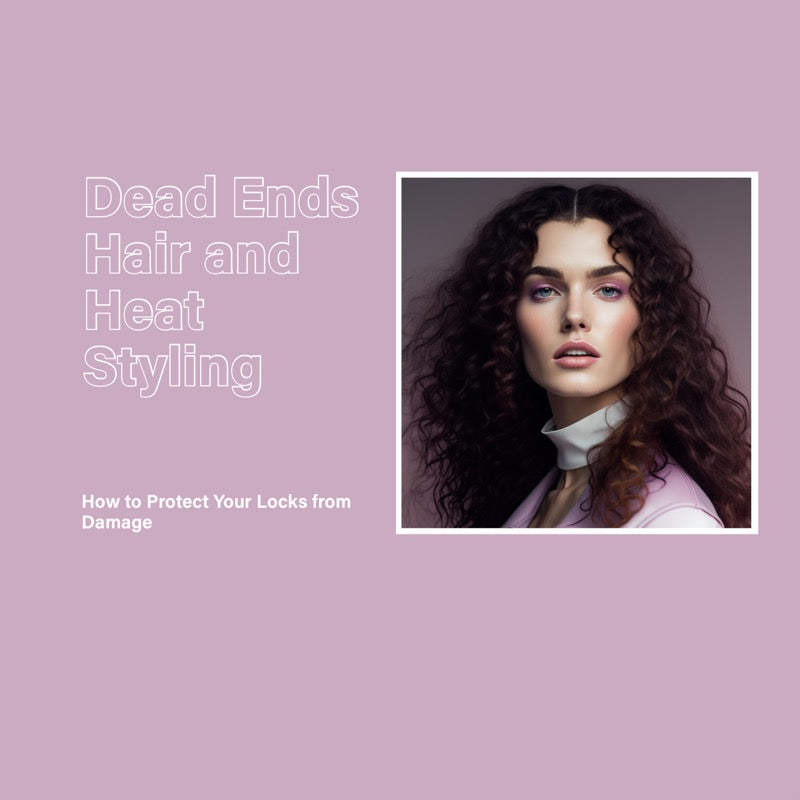In this article, we'll explore the relationship between heat styling and dead ends hair, and provide a step-by-step guide to help you protect your locks from damage.
As a bonus, we'll introduce you to a fantastic product called Coco Creme, a leave-in conditioner designed to moisturize, detangle, improve manageability, protect hair from damage, and add shine.
The Connection Between Heat Styling and Dead Ends Hair
Heat styling tools, such as flat irons, curling irons, and hair dryers, can cause significant damage to your hair, primarily when used frequently or at high temperatures. This damage weakens the hair shaft, leading to split ends and dead ends hair.
How Heat Damages Hair
Heat styling removes moisture from your hair, causing it to become dry, brittle, and more susceptible to breakage. It also affects the hair's natural proteins, which are responsible for its strength and elasticity. As a result, your hair loses its natural shine and becomes more prone to dead ends.
Step-by-Step Guide to Protect Your Hair from Heat Styling Damage
Limit Heat Styling
Reducing the frequency of heat styling is the most effective way to prevent dead ends hair. Instead, embrace your natural hair texture and experiment with heatless styling techniques, such as braiding or twisting your hair before bedtime to create loose waves.
Use a Heat Protectant
Before using any heat styling tools, apply a heat protectant spray or serum. This product forms a protective barrier on your hair, reducing the amount of direct heat exposure and minimizing damage.
Choose the Right Temperature
High temperatures cause more damage, so always use the lowest temperature setting required to achieve your desired style. Likewise, fine, thin, or color-treated hair is more susceptible to heat damage, so opt for lower temperatures when styling these hair types.
Don't Heat Style Wet Hair
Wet hair is more fragile and prone to damage, so always make sure your hair is dry before heat styling. Use a microfiber towel or an old t-shirt to squeeze out excess water gently, let your hair air dry, or use a hair dryer on the lowest heat setting.
Regular Trims
Schedule regular trims every 6-8 weeks to keep your hair healthy and free from dead ends. Even if you're trying to grow your hair, regular trims can help maintain its health and prevent further damage.
Introducing Coco Creme: Your Hair's New Best Friend
Coco Creme is a leave-in conditioner suitable for all hair types. Its key ingredient, Rice Amino Acid, provides numerous benefits, including:
- Moisturizing and detangling hair
- Improving manageability
- Protecting hair from damage
- Adding shine
Incorporating Coco Creme into your hair care routine can help protect your hair from heat styling damage and prevent dead ends hair. Here's how:
How to Use Coco Creme
After washing and conditioning your hair, apply a small amount of Coco Creme to your damp hair, focusing on the mid-lengths and ends. Comb through with a wide-tooth comb to distribute the product evenly and protect every strand.
The Power of Rice Amino Acids
Rice Amino Acids are effective ingredients that help to strengthen your hair and protect it from damage. They work by forming a protective barrier around the hair shaft, sealing in moisture and reducing the risk of breakage. Rice Amino Acids also help to improve hair's elasticity, making it more resilient to heat styling and other sources of damage.
Additional Benefits of Coco Creme
Coco Creme not only protects your hair from heat styling damage but also provides numerous other benefits that contribute to the overall health of your hair:
- Moisturizing: Coco Creme adds much-needed moisture to your hair, preventing dryness and brittleness that can lead to dead ends hair.
- Detangling: By smoothing and softening your hair, Coco Creme makes detangling more accessible, reducing the risk of breakage during brushing or combing.
- Improving manageability: Coco Creme helps to tame frizz and flyaways, making your hair more manageable and more accessible to style.
- Adding shine: The nourishing ingredients in Coco Creme impart a natural glow to your hair, making it look healthy and vibrant.
Tips for Combining Coco Creme with Heat Styling
To get the most out of Coco Creme and keep your hair protected from heat styling damage, follow these tips:
- Apply Coco Creme before heat styling: Always apply Coco Creme to damp hair before using heat styling tools. This ensures that your hair is adequately protected from heat and that the product can work effectively.
- Use a wide-tooth comb: After applying Coco Creme, use a wide-tooth comb to distribute the product evenly and detangle your hair gently. This helps to minimize breakage and damage.
- Allow hair to air dry: Whenever possible, allow your hair to air dry after applying Coco Creme. This reduces the need for additional heat styling and gives your hair a break from potential damage.
- Combine with other Nature Elixir products: For optimal results, use Coco Creme with other Nature Elixir hair care products, such as hair oils and serums. These products work together to improve the overall health of your hair and protect it from damage.
Conclusion:
In conclusion, dead ends hair and heat styling go hand in hand, but with proper care and protection, you can minimize the damage and keep your locks looking healthy and beautiful. By following the tips outlined in this article and incorporating Coco Creme into your hair care routine, you'll be well on your way to a healthier, happier hair journey.
FAQ:
Q: What is a dead end in hair?
A: A dead end in hair, also known as a split end, occurs when the hair shaft becomes damaged and frays at the tip. This is typically caused by heat styling, chemical treatments, and environmental stressors that weaken the hair and make it more susceptible to breakage.
Q: Can you fix dead ends without cutting?
A: While some products and treatments can temporarily seal and smooth split ends, the most effective and permanent solution for dead ends is to trim them off. Regular trims are essential for maintaining healthy hair and preventing further damage.
Q: Why does my hair keep growing dead ends?
A: Dead ends result from hair damage, which can be caused by various factors, including heat styling, chemical treatments, mechanical stress (e.g., brushing, combing), and environmental factors (e.g., sun exposure, pollution).
Q: How do you heal dead ends of hair?
A: Healing dead ends involves a combination of trimming them off and adopting a healthy hair care routine to prevent further damage. This may include using gentle hair care products, applying heat protectants before heat styling, limiting chemical treatments, and incorporating nourishing hair care products like Coco Creme to moisturize, detangle, and protect your hair.

